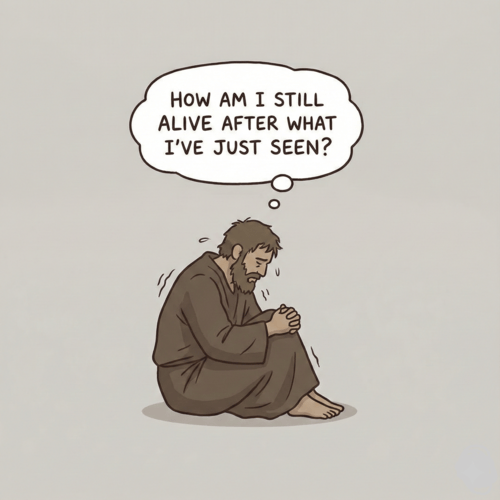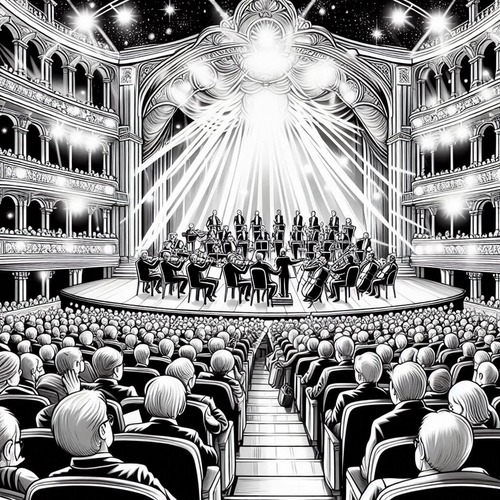The Inverted Retina: Design Flaw Or Optimal Engineering?
For decades, critics of Intelligent Design and Creationism have pointed to the human eye’s “backwards” retina as evidence against purposeful creation. After all, why would an intelligent designer place photoreceptors behind a layer of cells and nerve fibres that light must first pass through? Surely this arrangement—where light must travel through potentially distorting tissue before reaching the light-detecting cells—represents poor design?
This seemingly counterintuitive arrangement has been called “the wrong way round” and labelled as evidence of evolutionary constraints rather than intelligent planning. But what if this critique fundamentally misunderstands the engineering involved? Recent scientific discoveries reveal the inverted retina isn’t just adequate—it’s actually an elegant solution to multiple complex biological problems.
ENGINEERING ADVANTAGES OF THE “BACKWARDS” DESIGN
Optimal Oxygen and Nutrient Delivery
The photoreceptor cells in our retinas have among the highest metabolic demands of any cells in our bodies. They require extraordinary amounts of oxygen and nutrients to function properly. The inverted arrangement allows these critical cells to interface directly with the choroid—a highly vascularised layer rich in blood vessels that provides the necessary resources.
If our retinas were designed the other way around (as in octopuses), our photoreceptors would be separated from their critical oxygen supply, likely resulting in less efficient vision or requiring additional complex structures to maintain adequate perfusion. The inverted design elegantly solves the supply problem.
Efficient Heat Management
Less commonly discussed is the significant heat generated by photoreceptors during their continuous operation. The inverted design places these cells in direct contact with the choroidal blood supply, which serves as an effective cooling system. This arrangement prevents thermal damage that could otherwise impair visual function over time.
Waste Removal System
Photoreceptors produce considerable metabolic waste. The inverted arrangement facilitates immediate removal of these by-products through the adjacent blood vessels. This prevents toxic accumulation that would otherwise damage these delicate cells and impair vision.
THE INGENIOUS MÜLLER CELLS: NATURE’S FIBRE OPTICS
Perhaps the most remarkable feature addressing the supposed “flaw” of the inverted retina is the presence of specialised Müller cells. These cells extend through the entire thickness of the retina and function as living fibre optic cables.
Research published in prestigious journals such as Nature demonstrate that Müller cells:
- Guide light through the “backwards” retina with minimal distortion
- Actually enhance certain wavelengths important for human vision
- Reduce scatter and focus light precisely onto photoreceptors
- Filter out potentially damaging UV radiation
Dr. Kristian Franze and colleagues at Leipzig University showed these cells capture and transmit light with remarkable efficiency. Far from being a design compromise, this arrangement may actually improve image quality by reducing scatter and allowing for specialised light processing before photoreception occurs.
THE BLIND SPOT: A NECESSARY TRADE-OFF
Critics often point to the blind spot—where the optic nerve exits the eye—as further evidence of poor design. However, this represents a necessary engineering trade-off given the overall architecture. Consider these facts:
- The blind spot occupies less than 1% of our visual field
- Our brain’s sophisticated image processing compensates so effectively that we rarely notice it
- The alternative (an octopus-like design) would require photoreceptors to be disconnected from their optimal nutrient supply
- Having two eyes further compensates, as blind spots don’t overlap in our binocular vision
CEPHALOPOD COMPARISON: DIFFERENT DESIGN FOR DIFFERENT NEEDS
Octopuses and squids do indeed have “forward-facing” retinas without a blind spot. However, this alternative design comes with significant trade-offs:
- Lower visual acuity compared to vertebrates
- Greater vulnerability to retinal damage from bright light
- Shorter lifespan of the visual system
- Different ecological needs and shorter overall lifespan
The cephalopod eye design works well for their specific ecological niche and shorter lifespans but would be unsuitable for longer-lived vertebrates with our visual requirements. Different design parameters call for different solutions.
RECOGNISING PURPOSEFUL DESIGN
When we examine the vertebrate eye as an integrated system rather than focusing on isolated features, we see multiple interdependent systems working together with remarkable precision. The inverted retina represents not a flaw but a sophisticated engineering solution that:
- Maximises oxygen and nutrient delivery to the photoreceptors
- Provides effective cooling for metabolically active tissues
- Enables efficient waste removal
- Incorporates specialised light-guiding structures (Müller cells)
- Trades a minimal blind spot for significant functional advantages
This pattern of integrated complexity solving multiple problems simultaneously points strongly toward purposeful design rather than unguided processes.
CONCLUSION: BEYOND SURFACE-LEVEL CRITIQUE
The inverted retina reminds us to be cautious about quick dismissals of biological structures as “poorly designed.” What initially appears counterintuitive often reveals deeper engineering wisdom upon closer examination.
Far from being evidence against intelligent design, the vertebrate eye’s architecture demonstrates sophisticated problem-solving that elegantly balances multiple competing requirements. The inverted retina isn’t a design flaw—it’s a testament to optimised engineering that continues to inspire both awe and biomimetic applications.
The next time someone points to the inverted retina as evidence against design, perhaps we should ask: Would we really design it differently if we fully understood all the constraints and requirements at play?
RELATED FAQs
How do Müller cells specifically function as “fibre optic cables” in the inverted retina? Müller cells have a unique funnel shape and contain specialised proteins that provide a higher refractive index than surrounding tissue. This structure creates a light-guiding channel that minimises scattering and delivers photons directly to photoreceptors with minimal distortion, similar to how engineered fibre optic cables work. Recent research has shown they even focus specific wavelengths most important for human vision.
- If the inverted retina is optimal, why do some animals like cephalopods have a non-inverted design? Different organisms have different environmental constraints, lifespans, and visual requirements that demand different engineering solutions. Cephalopods (octopuses, squids) live relatively short lives in aquatic environments where their non-inverted design provides adequate vision without the longevity concerns vertebrates face. This represents specialised design for specific ecological niches rather than one design being universally superior.
- How does the inverted retina design protect against damage from excess light exposure? The inverted design positions the retinal pigment epithelium (RPE) directly behind photoreceptors, allowing it to absorb excess light that passes through them. This arrangement prevents damaging light reflection within the eye and enables the RPE to participate in the vital process of photoreceptor renewal. Additionally, the RPE’s strategic position helps shield photoreceptors from oxidative stress, effectively extending the visual system’s functional lifespan.
Do other vertebrates with different visual needs still have inverted retinas? Yes, all vertebrates—from fish to birds to mammals—share the inverted retina design despite vastly different visual requirements and environments. Birds with exceptional visual acuity, nocturnal animals with specialised night vision, even deep-sea fish living in near darkness all utilise the inverted arrangement. This consistency across diverse environmental demands strongly suggests the design offers fundamental advantages regardless of specific visual specialisation.
- What happens when the retina becomes detached, and does this relate to its inverted design? Retinal detachment occurs when the neural retina separates from the RPE and choroid layer that supplies its oxygen and nutrients—a medical emergency that highlights the critical relationship in the inverted design. This vulnerability exists precisely because the photoreceptors depend on their intimate connection with the underlying vascular layer for survival. The condition illustrates how the inverted arrangement creates a vital interdependence between structures that enables normal visual function.
- How does embryonic development inform our understanding of retinal design? During embryonic development, the retina forms from an outgrowth of brain tissue, with the inverted arrangement emerging naturally from this developmental pattern. This elegant developmental pathway allows for the precise formation of neural connections and specialised cell types necessary for vision. Rather than representing a design flaw, the inverted arrangement appears to be the most straightforward developmental solution for creating a functional visual system connected to the brain.
Could intelligent engineers design a better eye without the inverted retina? Even with our advanced technology, human engineers haven’t created any visual system that matches the eye’s performance, efficiency, and self-maintaining properties. Attempts to design artificial retinas for medical applications still fall woefully short of the natural eye’s capabilities despite billions spent in research funding. When all constraints are considered—oxygen requirements, waste removal, heat dissipation, developmental pathways, and long-term stability—the inverted design may well represent an optimal solution even by engineering standards.
OUR RELATED POSTS
- The Ankle and Feet: A Miracle of Precision Engineering
- Our Consciousness and Rationality: Is God the Best Explanation?
- DNA Evidence for Intelligent Design: New Challenges for Evolution
- Human Immunology: Evidence of Design in Our Defence Systems
- Nature’s Ultimate Computer: The Human Brain Defies Evolution
- Haemoglobin Screams Design: A Miracle in Every Breath
Editor's Pick

The Throne-Room Vision: Who Did Isaiah See?
The scene is unforgettable: Isaiah stands in the temple, and suddenly the veil between heaven and earth tears open. He [...]

The Angel of the Lord: Can We Be Certain It Was Christ All Along?
Throughout the Old Testament, a mysterious figure appears: the Angel of the LORD. He speaks as God, bears God’s name, [...]
SUPPORT US:
Feel the Holy Spirit's gentle nudge to partner with us?
Donate Online:
Account Name: TRUTHS TO DIE FOR FOUNDATION
Account Number: 10243565459
Bank IFSC: IDFB0043391
Bank Name: IDFC FIRST BANK






